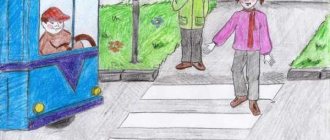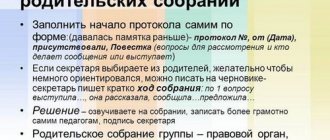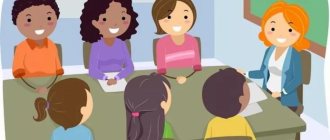Summary of the parent meeting on the topic “Children’s safety on the road”
Author: Kruglikova Olga Stepanovna
Summary of the parent meeting in the preparatory group
Parent meeting in the preparatory group on the topic “Children’s safety on the road.”
Author: Olga Stepanovna Kruglikova, teacher at MBDOU No. 90, Kemerovo.
Target:
Pedagogical education and involvement of parents in the process of teaching preschoolers the skills of safe behavior on the roads and streets of the city, developing a sense of responsibility for the life and health of their children.
Tasks:
— Familiarize parents with the theoretical foundations of road safety. — To create motivation in parents to self-develop a culture of safe behavior for children on the streets and roads. — Create conditions for interaction with society to prevent road traffic injuries among preschool children.
Parent meeting agenda:
1. Opening remarks. 2. Message from the group teacher. 3. Recommendations for parents on teaching children traffic rules.
4. Distributing a handout for parents “What can I do?”
Progress of the parent meeting:
1. Opening speech by the teacher:
“Our children were born to live joyfully. To play together, to be strong friends, to give smiles to each other and flowers, so that dreams always come true in their lives.”
Yes, our children are born precisely for this, but whether this always happens, whether life will be overshadowed by tragedy - this largely depends on us, adults. The topic of today's meeting is “Children's safety on the road.” The need for a meeting on traffic rules is dictated by life itself. The terrible statistics of child mortality and health damage as a result of road accidents are simply terrifying. And most often we, the adults, are to blame for tragedies. At this meeting we will talk about what parents can do to keep their child safe on the road. First of all, parents should understand that this task of protecting their child on the road is fundamentally unsolvable. Firstly, any movement by transport (and even on your own feet) is associated with danger, and the probability of the unexpected happening is always different from zero. This was not said at all to scare parents, but on the contrary, to draw their attention to the fact that you should always take care of the children’s safety (and your own). Secondly, the task of protecting the child once and for all cannot be solved, because the child is growing, and the possible dangers that await him on the road are growing. Therefore, children should be promptly taught the ability to navigate a traffic situation, cultivate the need to be disciplined on the street, careful and prudent. And parents should not make the most common mistake - acting on the principle “you can do it with me.” If you show your child by your own example how to run to red, be sure that when left alone, he will try to repeat this trick. Dear parents! Remember, if you break the Rules, your child will do the same! We have the power to develop the skills of safe behavior on the roads, to educate a conscious and competent pedestrian, responsible for the life and health of road users.
2. Message from the group teacher.
Today's children have to live with incomparably more aggressive traffic, and therefore every day it is becoming more and more difficult to ensure their safety. It is very important from preschool age to develop in children the skills of safe behavior on the road and to raise law-abiding citizens. Our task is to develop in children an understanding of the dangers that the automotive world conceals. It is important to do this before the child adopts and accepts the wrong stereotypes of behavior on the road, which, unfortunately, are currently prevalent in the adult environment. The study of traffic rules in kindergarten takes place in special classes, during games (didactic, active, role-playing), entertainment, etc. The topic of traffic rules covers not only educational, but also other types of classes - mathematics, familiarization with fiction, arts and crafts, physical education, etc. In classes, children learn to navigate in space, simulate various situations on the road, and play them out. We also form motor skills in children: children must not only move correctly in accordance with the received signal or, focusing on an adult, but also be able to coordinate their movements with the movement of other people and the movement of objects. In addition, with the help of didactic games we try to develop voluntary, active attention, because For safe behavior on the streets, it is necessary to develop in children voluntary attention and the ability to concentrate on the road situation. Preschool children are a special category of pedestrians and passengers. They cannot be approached with the same standards as adults, so there is a need to create a certain system to familiarize children with traffic rules and instill in them the skills of safe behavior on the roads and streets of various settlements. It is safe to say that work in this area is being carried out quite effectively, since for several years now no violations or accidents involving pupils of our kindergarten have been recorded. Our goal is not only to give children knowledge about the rules of the road, but also to develop in them the skills to adequately apply this knowledge in various situations, so that these skills develop into a habit.
3. Recommendations for parents on teaching children traffic rules.
Let me remind you once again of the basic rules that a child should know:
1. Basic terms and concepts of the rules. 2. Responsibilities of pedestrians. 3. Responsibilities of passengers. 4. Traffic regulation. 5. Traffic lights. 6. Warning signals. 7. Traffic across railway tracks. 8. Traffic in residential areas and transportation of people. 9. Features of cycling.
Remember! The child learns the laws of the roads, following the example of family members and other adults. Don't waste time teaching your children how to behave on the road. To prevent your child from creating a dangerous situation on the roads, he must be able to: • watch the road; • correctly assess the road situation in all its variability; • see, listen, anticipate, avoid danger.
Watch the road.
1. It is necessary to teach children not only to follow the traffic rules, but also from a very early age to teach them to observe and navigate. It must be taken into account that the main way to develop behavioral skills is through observation and imitation of adults, especially parents. 2. When you are on the roadway with your child, do not rush, cross the road at a measured pace. Otherwise, you will learn to rush where you need to watch and ensure safety. 3. Teach your child to notice a car. Sometimes a child does not notice a car from afar. Teach him to peer into the distance. 4. Teach your child to estimate the speed and direction of the future movement of the car. Teach your child to determine which one is going straight and which one is preparing to turn. 5. Teach your child to watch. The habit of inspecting the street in both directions should be brought to automaticity before taking the first step from the sidewalk to the roadway. You need to look especially carefully at the street when there is a family home or acquaintance on the opposite side, or when a child crosses the street with other children - it is in these cases that it is easy to miss the car.
Correctly assess the road situation.
The main danger is a stationary car. Why? Yes, because having seen the approaching car in advance, the pedestrian will give way to it. A stationary car deceives: it can block a moving one, preventing you from noticing the danger in time.
Rule #1.
You cannot go out onto the road because of parked cars. As a last resort, you need to carefully look out from behind a standing car, make sure that there is no danger, and only then cross the street. Watch with your child the cars standing at the edge of the roadway and pay attention to the moment when another one suddenly appears from behind the standing car. Draw your child's attention to the fact that a bus standing at a stop also makes it difficult to see the car moving behind it.
Rule #2
You need a parked bus neither in front nor behind! A standing bus, no matter how you go around it - in front or behind, covers a section of the road along which a car can pass at the moment when you decide to cross it. In addition, people near the bus stop are usually in a hurry and forget about safety. We have to wait until the bus leaves.
Rule #3
And at the traffic lights you can meet danger! Children often reason like this: “The cars are still standing, the drivers see me and will let me through.” They are wrong. Immediately after turning on the green signal for drivers, a car that was not visible behind the standing cars and whose driver cannot see the pedestrian may enter the crossing. If the green traffic light for pedestrians goes out, you need to stop. The child must not only wait for the right light, but also make sure that all the cars have stopped.
Rule #4
Develop in your child the habit of always stopping, looking around, listening before going out on the road, even if there are no cars on it, and only then cross the street.
Rule #5
Strong transport behavior skills in children are formed only through daily systematic training! During every walk with children, trips with them on business, to visit, out of town, etc. teach them to observe the street and transport, analyze the road situations encountered, see dangerous elements in them, and act accurately in various circumstances.
Rule #6
There is no need to instill in children an excessive sense of fear of traffic and moving cars. Let everything that is connected with kindergarten (and later school), including the road, be associated with the bright and kind in the child. At the same time, you need to teach him to be attentive, and this is not an easy thing. The processes of perception, attention and reaction in a child and an adult are completely different. Experienced drivers know, for example, that sounding the horn when they see a child running across the road is dangerous. The child may act unpredictably - instead of stopping, he may rush without looking back under the wheels of another car. Even those children who know the rules of the road sometimes break them. Don't take the trouble to help the children. You may have to stop a child who doesn't want to wait for a traffic light. Do it kindly.
4. Distribute reminders for parents “What can I do?”
Memo “What can I do?” (Appendix No. 1) will tell you what parents can do to keep their child safe on the road.
So, if you teach your children to follow these basic rules of behavior on the roads, then trouble will not come to your home.
In conclusion, it is worth noting that studying traffic rules is just as necessary as studying basic subjects (mathematics, Russian language). After all, the safety of our children’s lives is no less important than the indicator of their intellectual development, and even much more significant. When teaching a child the rules of the road, an adult must clearly understand what needs to be taught and how to do it more effectively. He himself must be well versed in road situations. Therefore, you should not only analyze your life experience in advance, but also study the necessary literature on the topic “Road Rules”. What and, most importantly, how well we teach a child, what skills of safe behavior on the street we instill in him, will protect him all his life. Attached files: comments powered by HyperComments
Parent meeting in the second junior group “Safe roads for children!”
Where does child safety on the road begin?
(parents’ answers) (
From timely training to navigate a traffic situation, nurturing the need to be disciplined on the street, prudent and careful.)
“You, your child and the rules of the road.”
First of all, let's find out: what is traffic?
(Movement of vehicles and pedestrians on roads).
Who is a road user?
(Motorists, motorcyclists, cyclists, pedestrians.)
What is a “rule”?
(A law, an order that cannot be violated)
Why are traffic rules necessary?
(To ensure safe traffic on the roads.)
What helps you obey traffic rules?
(Road signs, traffic lights, road markings.)
What traffic signs do you see on the way to kindergarten?
Do you conduct conversations with your child according to pedestrian rules?
Have you ever violated traffic rules? Why?
Do you remind your children how to cross the road correctly?
Rules of conduct for pedestrians.
— When do you and I become pedestrians, road users? (from the moment you leave home).
- Let's discuss what rules of pedestrian behavior do we know?
(list, discuss).
Game "Situation on the street."
Purpose of the game: relieve emotional stress; In this game, situations are played out with parents.
1. Mom and son are walking down the street. On the opposite side, the boy sees his dad and rushes across the road to him.
Question. What should mom have done?
2. Dad walks with his child along the sidewalk. The child has a ball in his hand. The ball falls on the road. The child runs after him.
Question. What should dad do?
Analysis and discussion of the game.
Conclusion.
Conclusion: A child can be taught to comply with all safety requirements without resorting to intimidation.
(Recommendations are given to parents on teaching children traffic rules and developing street behavior skills.)
Personal example is the most intelligible form of teaching for a child. Remember, if you break the Rules, your child will do the same!
Teach your child to look. The child must develop a solid skill: before taking the first step from the sidewalk, he turns his head and examines the road in all directions. This should be brought to automaticity.
Teach your child to notice a car; sometimes children do not notice a car or motorcycle from afar. Teach him to peer into the distance.
Teach your child to estimate the speed and direction of the future movement of the car. Teach him to determine which one is going straight and which one is preparing to turn.
It is necessary to teach children not only to comply with traffic rules, but also to observe and navigate from a very early age. It must be taken into account that the main way to develop behavioral skills is through observation and imitation of adults, especially parents. Many parents, without understanding this, teach their children by personal example how to behave incorrectly on the streets and roads.
Parent meeting on traffic rules in the senior group
Parent meeting in the senior group on the topic “The role of the family in raising a competent pedestrian.”
Abstract Description: I bring to your attention a summary of the parent meeting in the form of an exam for children of the senior group and their parents. The presented material will be of interest to educators working in senior groups of preschool educational institutions. Stages of preparation 1. Questioning parents Topic: “Road Rules” 2. Preparation of an exhibition of drawings on the topic “Respect the traffic light.” 3. Design of an exhibition of children's literature together with the children's library. 4. Learning poems with children about traffic lights, pedestrian crossings and the rules for crossing the road. 5. Preparation of a multimedia presentation “Educating a competent pedestrian!” 6. Design of a poster on the theme of the meeting: “To be an example to children, You need to know about everything in the world, Study the rules of the road with your child and never break them yourself.”
7. Development of instructions for parents “Rules of Smart Parents”, Diplomas of Inspector Peshekhodov.
Objectives: 1. Expand children's knowledge about the rules of behavior on the street; repeat the duties of pedestrians, the rules for the movement of pedestrians on the sidewalk and across the roadway in groups and individually. 2. Involve parents in the problem of children's road injuries. To acquaint parents with the age-related psychological characteristics of children, due to which accidents involving children occur. 3. Test the knowledge of children and their parents about traffic rules. Expected result: 1. Children and parents confidently name the rules of the road while completing tasks. 2.Parents have mastered the program material on traffic rules for children 5-6 years old. They understand the characteristics of children’s behavior on the road, as they have become familiar with the age and psychophysiological characteristics of children. Progress of the meeting The meeting is held in the music room of the kindergarten Educator - Today our meeting is devoted to the very important topic “The role of the family in raising a competent teacher.” Questioning parents First, I would like to know how you assess the level of knowledge of traffic rules in your children. To do this, I suggest answering the questions in the questionnaire. You must choose the answer YES or NO. Independent work of parents Parents are given a leaflet on the physiological and psychological characteristics of preschool children. Time for independent reading: 3 minutes. Draw a conclusion. Parents' conclusion: The most common causes of road accidents: 1. Entering the roadway in an unspecified place in front of nearby traffic (few of our children have the habit of stopping before crossing the roadway, carefully inspecting it before crossing the roadway, carefully inspecting it with turn your head and control the situation on the left and right while moving). 2. Entering the roadway because of a bus, trolleybus or other obstacle (our children are not used to walking to a pedestrian crossing after getting out of a vehicle or inspecting the roadway before leaving from behind bushes or snowdrifts). 3. Playing on the roadway (our children are used to the fact that all free territory is a place for games). 4. Walking along the roadway (even if there is a sidewalk nearby, most children have the habit of walking along the roadway, most often with all sorts of violations). Teacher's comments: Typical age and psychophysiological characteristics of senior preschool children and their often unpredictable behavior. — On the street, children are often distracted by everything interesting: a bright car, a flying plane, people, animals, etc. If a seven-year-old child walks in the company of peers, he often gets carried away in conversations, does not look at the road and may not hear the car signal due to lack of attention. Children with a strong nervous system who love noisy games react quickly to loud sounds. As a rule, they run away from danger and fall under the wheels of cars. And in children with a weak nervous system, the reaction to sounds and light signals is slow. In dangerous situations, they become inhibited and become lost, not knowing what to do. It makes no sense to demand from a slow child the same quick reaction as from an active one. They have different types of nervous systems, so the approach to education must be appropriate. You can’t punish a child; everything needs to be explained to him in detail. There are differences in the reactions of boys and girls to moving vehicles. Boys usually try to cross the road as quickly as possible, without calculating the distance between themselves and the car and without thinking about the fact that the cars are walking in several rows. Girls can stop and run back. It also happens that a child standing on the sidewalk suddenly takes off and rushes across the flow of cars. In addition, children's behavior may be influenced by their functional state at a particular time. For example, a child does not feel well, did not get enough sleep, is tired. As a result, his ability to control himself decreases. Absent-minded children require special treatment. The cause of absent-mindedness may be fatigue or reluctance to do anything. Our children assess the situation on the road differently than adults. Children's holistic perception of the road situation is difficult due to the child's small stature. Parked vehicles block his view. The child does not see what is happening on the road. He cannot make a decision quickly; he is not able to correctly assess the road situation. As a result, he gets hit by a car. Parents should develop in their children sensorimotor and intellectual skills for safe behavior on the streets and roads. In the process of development and education, older preschoolers and younger schoolchildren gradually develop their own habits, character traits, abilities, and skills. Observing this, parents can direct, for example, the child’s increased excitability to enhance his cognitive activity, getting him interested in technology and rules of safe behavior. To do this, you can use outdoor games to teach road safety. Dear parents! Be attentive to your children and patient. Accompany your children to kindergarten, school, library. Develop in them the skills of safe behavior on the streets and roads. Game learning situations Children enter the hall. They are met by a teacher dressed as a Pedestrian Inspector and invites them to approach their parent. The presentation “Educating a competent pedestrian” is included, which consists of interactive tasks. If done correctly, the correct answer appears on the screen. The teacher talks about how important an adult’s personal example is in raising a competent pedestrian. — Let us remember the wonderful words of A.S. Makarenko: “Do not think that you are raising your child only when you are talking, or teaching him, or ordering him. You are raising him at every moment of your life, even when you are not at home.”
Personal example of parents... they often talk and write about its necessity in education. Needless to say, how children copy the behavior of their mother or father on the street. However, parents do not always set a worthy example for their child in following the rules of safe behavior, safe crossing of streets and intersections, and boarding the bus. By violating traffic rules, parents seem to tacitly allow their children to break them. In 1982, right-hand traffic, speed limits in cities, technical compliance of crews, and license plates were introduced. Since then, the rules have been adjusted and changed, but some have survived to this day and need to be known and followed! Therefore, today you and your children will take the exam of real pedestrians! The first task is to choose the right traffic light!
The correct answer is A. Now you have to color the traffic lights in the correct colors. Let's start coloring from the topmost traffic light. Only the correct circles will take their place, be careful.
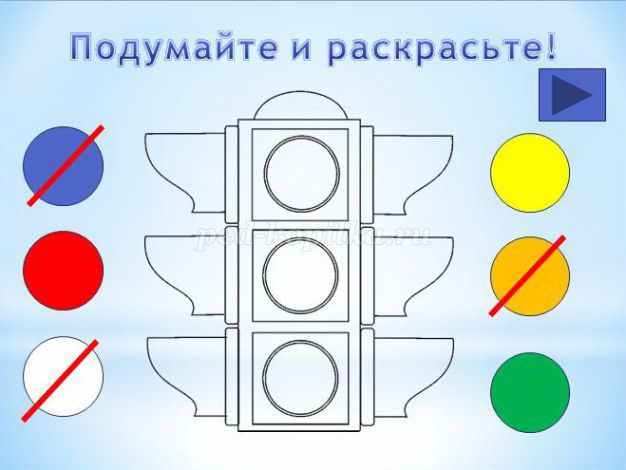
Inspector Pedshekhodov has a doll in his hands - Baby. Finding himself in a big and noisy city, the Kid was confused, the Kid disappeared... Not knowing the traffic lights, he almost got hit by a car! There are cars and trams all around, then suddenly a bus is on the way. To be honest, the Kid doesn’t know where to cross the road. Guys, you help him. And, if possible, tell me how to cross the road without getting run over by a bus? Pre-prepared children read by heart. 1st child. Attention: the three-eyed traffic light is staring at you. Green, yellow, red eye, he gives orders to everyone... 2nd child. The red eye lights up, and when it lights up, everyone stands - that’s the law! 3rd child. Yellow flashed - wait! And the green light - go. - Guys, tell me, who is a pedestrian? Children and parents. A pedestrian is someone who walks the streets. - The kid asks: “So, a pedestrian can walk wherever he wants?” Children and parents. Pedestrians are only allowed to walk on sidewalks or on footpaths, keeping to the right. - That's right, well done! Now find where the sidewalk is shown in the picture and click on the arrow that points to the sidewalk.
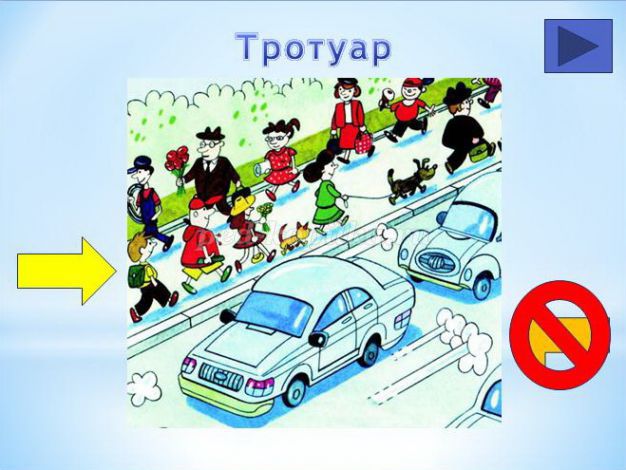
If you choose the wrong arrow, a prohibition sign will appear. The correct answer is a yellow arrow pointing to the sidewalk. 4th child. When walking along the sidewalk, you must stay on the right side. On a narrow sidewalk, you need to give way to a pedestrian walking towards you. Be careful when passing a car parked near the sidewalk - passengers in the car may open the door and hit you. And if you pass by the gate, be very careful - a car may drive out of the gate. – Next task. You need to find a pedestrian crossing sign. Only the correct drawing will turn into a red square.
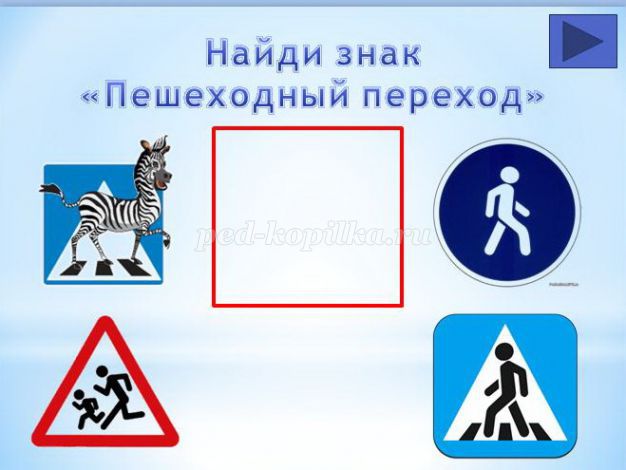
The correct one is the bottom right picture of the 5th child. Walking carefully, watch the street and only where you can cross it. Educator. You can cross the street only where there are markings on the roadway - “Zebra” or a road sign “Pedestrian crossing”. What types of pedestrian crossings are there? Children and parents. Ground or “Zebra”, underground and above ground. In this task we will select the correct sign for the underground passage, if you have chosen the correct sign, it will appear in the picture.
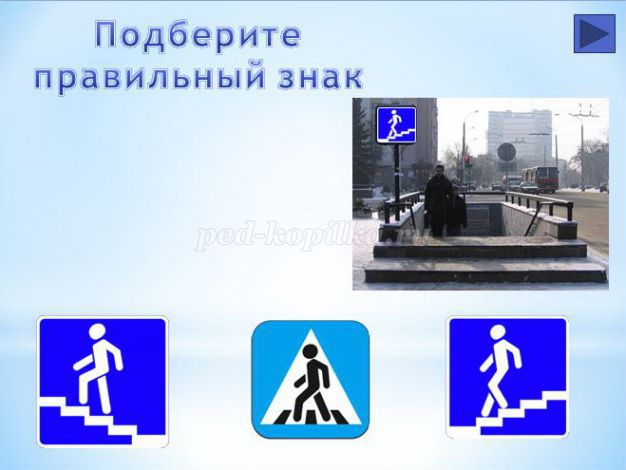
And on this slide, select the correct sign for the pedestrian crossing. The next task is to select the correct sign for the elevated pedestrian crossing. If you choose the correct sign, it will appear in the picture.
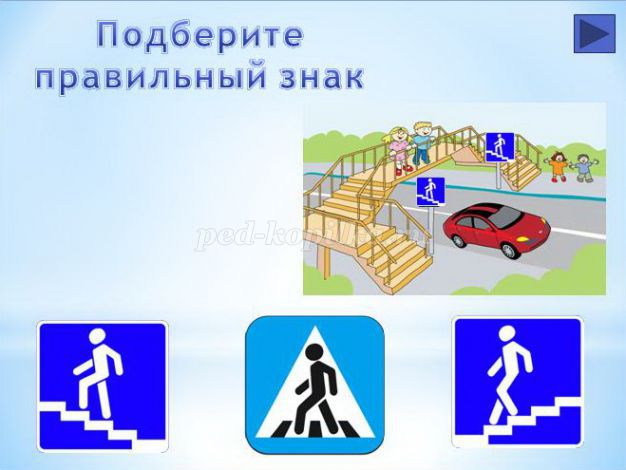
Now let's select only those pictures where pedestrians cross the road correctly.
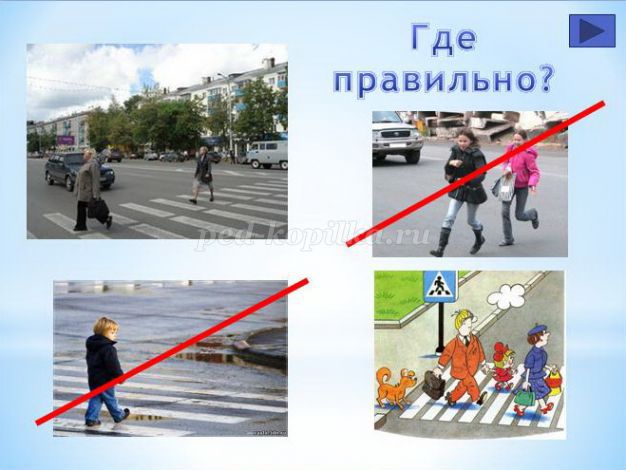
Let's think about what's wrong in the picture in the upper right corner. Children and parents. The girls cross the road in the wrong place, right in front of a moving car. Educator. That's right, but why is the bottom left picture not correct, because the baby is crossing the pedestrian crossing? Children and parents. Because a child should not cross the road alone, only with adults. - And the last task. Move the baby squirrel across the road. Think about which arrow shows the correct direction of movement - orange, yellow, blue or green.
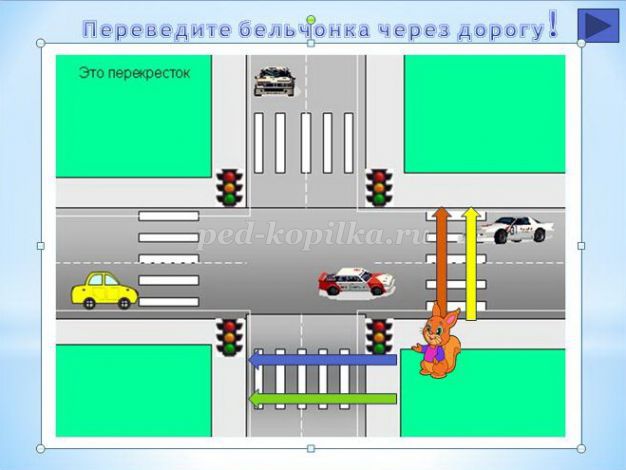
The correct answer is the blue arrow. And so you are all WELL DONE! Now let’s test your knowledge in practice and play the game “If you walk correctly, you will cross the road!” Description. Children must walk along a zebra crossing, an underground passage (tunnel) and an overpass (along a bench). Parents help children complete the task. Draw the attention of parents to the fact that children should cross the road only on the right side! The game is being played. 6th child. They don’t just walk around the city, on the street: When you don’t know the rules, it’s easy to get into trouble. Be careful at all times and remember in advance The driver and the pedestrian have their own rules. Congratulations, you have passed the pedestrian exam and are awarded the Pedestrian Inspector diploma!
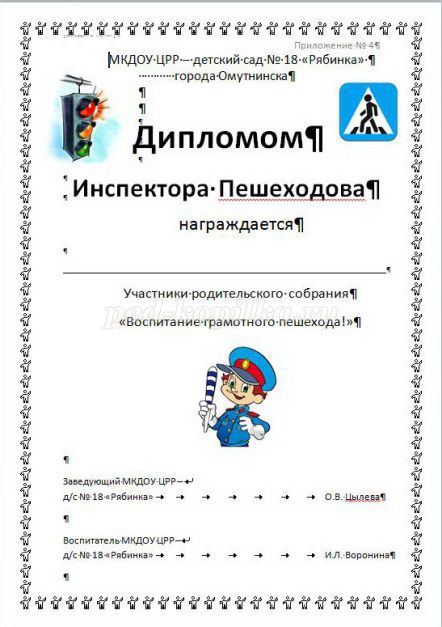
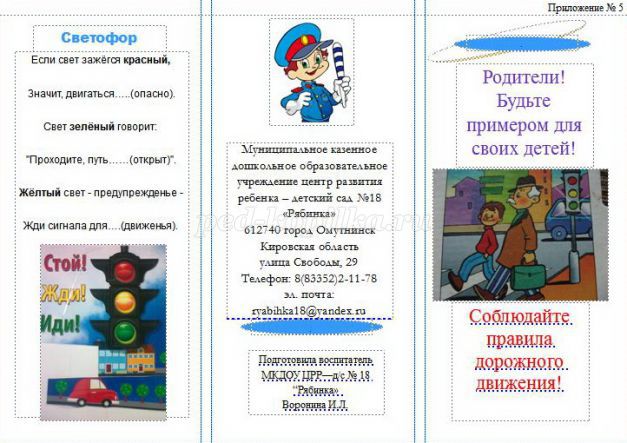
We recommend watching:
Parent meeting in the senior group on the topic: “Development of speech when getting to know nature” Cognitive and playful leisure time on traffic rules for children and parents of the middle group of kindergarten Summary of the parent meeting in the senior group on traffic rules Parent meeting on traffic rules in kindergarten. Senior group
Similar articles:
Parent meeting in kindergarten “Children’s safety on city streets”
Protocol for parent meetings on the prevention of injuries in children while riding a bicycle
author: Khanzadyan Amalia Martunovna
teacher GBOU School No. 536 DK No. 3
Protocol for parent meetings on the prevention of injuries in children while riding a bicycle
PROTOCOL No. __
GENERAL PARENTS MEETING ON THE TOPIC: “SAFE BICYCLE”
Prepared and conducted by: Full name.
The meeting was attended by - __ people.
Goal: to promote compliance with traffic rules and prevent child injuries on the road.
Objectives: To encourage parents to think that compliance with traffic rules is the most important thing for preserving the life and health of their children. Pay attention to the psychological aspect of the problem. Inform parents about the need to use personal protective equipment: helmet, gloves, knee pads, elbow pads.
Agenda:
- Formation of safe behavior of children on roads and streets.
- Conversation about the rules of cycling.
- Personal protective equipment for children
Progress of the meeting:
Relevance of the chosen topic. The need for a meeting on traffic rules is dictated by life itself. The terrible statistics of child mortality and health damage as a result of road accidents are simply terrifying. And most often, we, the adults, are to blame for the tragedies. At this meeting we will talk about what parents can do to keep their child safe on the road.
- The teacher of the group, Svetlana Igorevna, spoke on the first issue.
She spoke about child injuries on the roads and the rules of safe behavior on the roadway. Then she gave advice to her parents. Svetlana Igorevna raised the important issue of how to protect children from road accidents. The main and common causes of road accidents are:
- Entering the roadway in an unspecified place in front of nearby traffic (few children have the habit of stopping before crossing the roadway, carefully inspecting it, turning their heads, and monitoring the situation on the left and right while driving).
- Exit to the roadway due to traffic.
- Games on the roadway.
- Walking along the roadway. It is parents who are the main link in teaching their children safety rules and traffic rules. How well a child will master safe behavior skills depends on the exemplary actions of parents and example. Traffic rules training should be:
- constant (frequent, short conversations with the child are better than long, but rare ones),
-specifically, it is necessary to focus the child’s attention on actions in real movement conditions,
-aimed (at instilling safe ways of behavior on the roads, and not just memorizing traffic rules,
- applied to the immediate environment.
2.On the second and third questions
Svetlana Igorevna had a conversation with parents about the rules of cycling and means of protecting children.
She noted that with the establishment of warm and sunny days, the number of children, teenagers and adults using two-wheeled vehicles to move and ride on streets, roads, and parks increases. Unfortunately, statistics show that children are injured every year while riding bicycles. To avoid this, a cyclist must not only know the rules of the road and the rules for using a bicycle, but also follow these rules.
Before you get on a bike, you need to remember the rules of equipment for the trip and the safety of the child.
It would seem that it would be so difficult - I got on my bike, took the wheel, and rode off. But in reality, it's not that simple. It is important to remember the safety rules when riding a bicycle.
First of all, remember: children under 14 years of age are not allowed to ride bicycles on roads and streets, only on special bicycle paths and areas closed to vehicles.
To prevent an exciting trip from turning into a dangerous one, make sure that your child is always wearing a helmet and protection on his knees and elbows. In most cases, the cause of severe injuries is the lack of a helmet. But without riding skills, even a helmet cannot save you from injuries.
Don't think that a child can get on an "adult" bike and ride straight away. It is necessary to correctly and carefully follow all safety rules. Ride together and help your child learn basic skills. A small cyclist definitely needs constant supervision. And he should only ride in places where cars do not drive.
First of all, try to automate the moment of braking (when there is a person, a wall, a hole or a child driving too fast in front). After stopping, you need to teach the child not to throw the steering wheel and stick his leg out. It is better to insure the baby only by the shoulders, and not to hold it, but to insure it. No need to grab the handlebars and saddle. Of course, at first there will be a collapse at every meter, but this will pass quite quickly.
EQUIPMENT.
Helmet. If a young cyclist struggles and does not want to put on a helmet, explain to him clearly that this attribute can save his life. Children are quite often biased towards him, largely relying on the opinions of their peers who like to brag about their fearlessness. Try to interest your child in the update, praise him for taking care of his life and health. And under no circumstances should you laugh, no matter how funny your baby looks in this helmet.
You can’t buy a helmet to grow: if it slides down over your eyes, it will only ensure a collision with the first pillar. The helmet should be comfortable for the child, fit tightly on the head, not press or wobble. In addition, it must have a good ventilation system and meet the standards.
A modern helmet has a convenient system of adjustment straps. When trying on protective attribute, adjust them so that the child is as comfortable as possible. The helmet clasp should be easy to unfasten with one hand. If this procedure is difficult for your child, then look for another helmet.
The color of the helmet is also important. Road users must be able to see the cyclist clearly. Let the helmet be bright and reflective. Almost no one will see dark helmets, and even at dusk.
It is important to remember: during the trip, the helmet must always be fastened and a hat must not be worn under it.
Clothes and shoes. A young cyclist's clothing should be bright for the same reason as a helmet (preferably with a couple of fluorescent stripes). Lightness is also taken into account so that the child does not overheat during the trip. Trousers should not be too long or too wide to avoid the risk of the leg getting caught in the bicycle chain.
Shoes should be as comfortable as possible and should not be tight or, conversely, dangle on the foot. No flip-flops or sandals.
Hands and palms also need protection. Cycling gloves are typically made with soft pads and no hard parts to allow for easy grip on the handlebars. If they fall, they will easily protect your baby’s palms and hands from scratches and bruises.
At the end of the conversation, the teacher handed out leaflets to parents with the principles of safe cycling:
PRINCIPLES WHEN RIDING A BIKE
.
- Don't drive without a helmet!
- Correctly selected bicycle
(according to the height, age and gender of the child). - You need to drive in the direction of traffic
, not against it. - Bike maintenance
: caring for wheels, chain, pedals, steering wheel. - It is important to teach your child how to fall off a bicycle correctly
in case of a critical situation. It is better to contact an instructor for advice. - The height of the seat should be such that the baby can normally reach the pedal with his straight leg in the lower position, but at the same time his foot should rest on it with the middle part.
- Teach your child to always pay attention to the quality of the chain protection so that the pant leg does not get caught in it, as this can lead to injury.
A CHILD MUST UNDERSTAND ONCE AND FOR ALL:
Bike
– This is a vehicle, not a toy.
Riding recklessly on it, riding on sidewalks or bike paths
, is strictly prohibited.
Any fall from a bicycle
can lead not only to abrasions on the arms and legs, but also to head and brain injuries, which can be very dangerous.
Ride a bike
Children under 14 years of age are prohibited from traveling with a passenger.
The iron “horse” is not designed to support the additional weight of a passenger. It will be less stable and difficult to control
, which affects
traffic safety
.
Teach your child these simple rules
, choose
the right
and comfortable equipment for him - and then cycling
will
bring only pleasure!
Svetlana Igorevna also recommended that parents use reflective elements in their children’s clothing so that drivers can see them in the dark.
Solution:
1. Please note that raising children to behave safely on the road is the main task of parents.
2.Parents must remember and convey to their children the rules and principles of safe cycling
3.Parents should follow the rules themselves, thereby setting a positive example for their children.
Protocol for parent meetings on the prevention of injuries in children while riding a bicycle
